Don’t Phase Me Bro: Do Double-Patched Channels and Aux-Fed Subs Cause Phase Issues?
The practice of double-patching channels is more common than ever due to modern consoles with high channel counts, but it’s not a recent innovation: a long-standing technique when mixing monitors from front of house has been to use a “Y” cable to split key inputs like lead vocal, which allows the operator to have independent control over the vocal treatment for the monitors without needing to compromise out front.
Spending more time mixing for in-ear monitors, I’ve come to appreciate a different use for double-patching: tonal control. Maybe every band member wants some kick drum in their IEM mix, but the drummer wants a lot of the low-end punch, and maybe the guitar player wants less punch and more top-end slap.
Using two kick mics – in and out – is a great solution here, but not always an option. We can create a similar effect by double-patching one kick mic, low-passing one channel to leave just the fundamental of the drum, and high-passing the other to leave just the beater attack.
Basic Concepts
Conversations about this technique with colleagues prompted me to investigate whether it produces unintended consequences – any time we’re filtering and then summing two coherent signals, we need to be aware of any potential lurking phase demons.
To test this, I patched a signal generator into two console channels, and ran a direct out from each into (Rational Acoustics) Smaart. In the following figures, the green and blue traces show the response of the EQ processing on each channel, while the red trace shows the result of summing both channels into the main mix bus.
In all cases, the results can be summarized by two basic concepts:
1. In the frequency ranges where one signal has a significant level advantage, the summed response will closely match that signal. With large amplitude differences, phase offset becomes irrelevant.
2. In the frequency ranges where the two signals are close in level, we can expect interaction between them. The relative phase offset will dictate the nature of the combined response.
Let’s start by bypassing all EQ on both channels, with the exception of an HPF on one channel (Figure 1). There’s probably no reason to actually do this in practice, but it’s a good look at the underlying mechanisms.
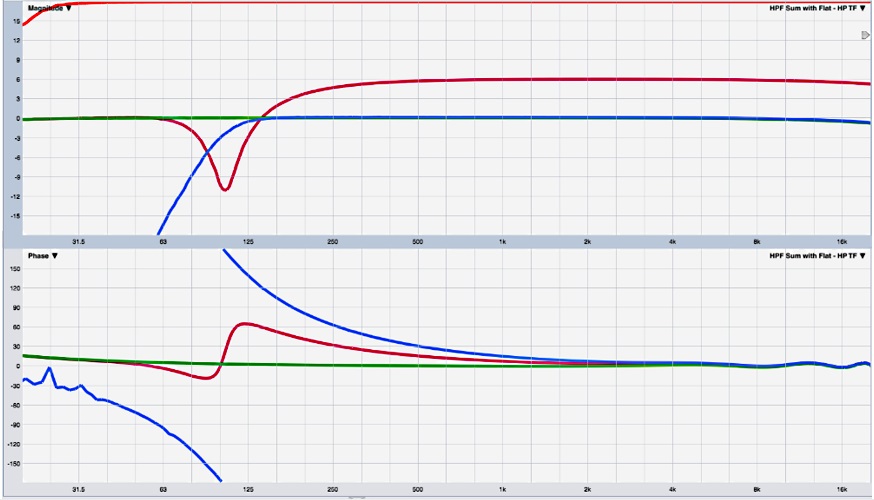
Figure 1
The response dip around 105 Hz is the result of the two signals being close in level but 180 degrees apart in phase. At lower frequencies, the HPF on the blue channel creates level offset, leaving the green channel to dominate the combined response. At higher frequencies, levels are matched, and phase offset approaches zero, so we see the full +6 dB summation that occurs with two coherent signals.
Note that this particular console has fourth order (24 dB / octave) high pass filters, which produce a phase shift of 180 degrees at fc. Consoles using a less steep filter, such as the second order (12 dB/octave) response shown in Figure 2, avoid the deep dip because, throughout the range in which the magnitudes are similar, the phase offset is not large enough to cause cancellation (>120 degrees).
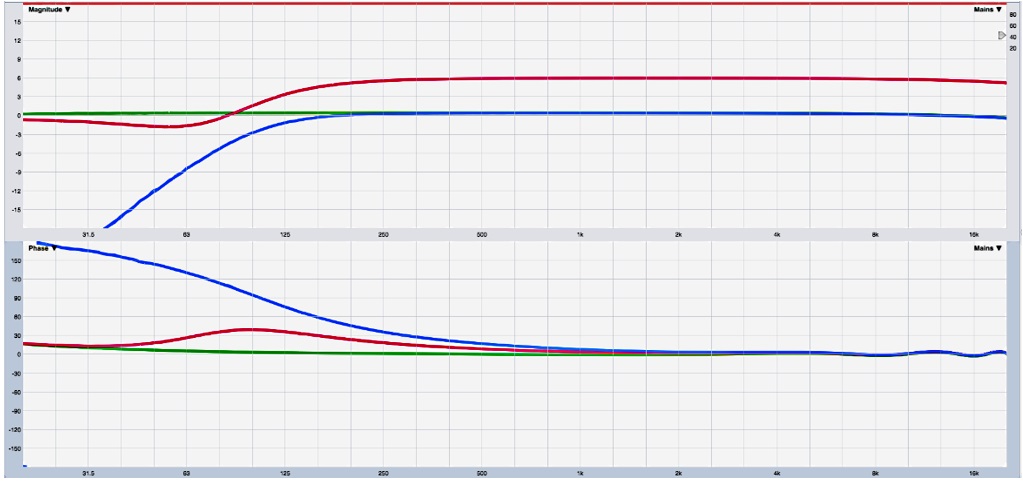
Now let’s look at a more realistic situation: the aforementioned single kick drum mic, double-patched into two input channels, and filtered to put the LF drum resonance on one fader and the HF beater attack on another. Perhaps we set the low-pass filter (LPF) to 100 Hz and the HPF to 1 kHz.
Figure 3 shows that the phase responses are certainly not matched throughout most of the spectrum – far from it, in fact – but this matters not, since the filter corner frequencies are so far apart that there is effectively no overlap. For those concerned that a 30 Hz HPF on the LF channel would further complicate matters, Figure 4 shows that concern is unwarranted, for the same reason.
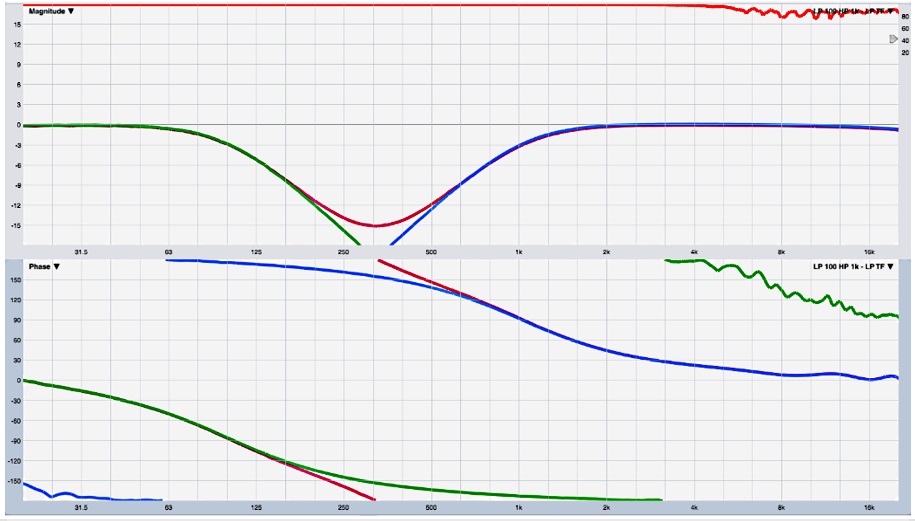
Figure 3

Figure 4
The key to success here is isolation. Since any potentially problematic interactions are limited to the frequency range where both signals are similar in level, we can rest easy in situations such as the kick drum double-patch, where the two ranges of interest are far enough apart to enjoy significant isolation. I would probably avoid this technique with full-range inputs such as electric bass, and instead use discrete double patched channels if different tones were required for different mixes.
However, it would be myopic to focus on the static situation. As soon as there is a fader level change between the two channels, we’ve shifted the effective crossover point and thus expose ourselves to a potentially different summation condition. (The term “crossover” in this context is a bit of a misnomer, but I’m using it here to refer to the frequency at which the filtered responses meet at equal level.)
Bigger Question?
As is often the case with these investigations, a new question arises which, in my opinion, is even more interesting: I have occasionally encountered the statement that, when mixing on a system configured with aux-fed subs, each channel’s subwoofer send level must be kept at unity, as sends at different levels effectively results in different crossover frequencies for each instrument through the PA. In theory, this is absolutely true. The question, again, is how problematic this is in practice?
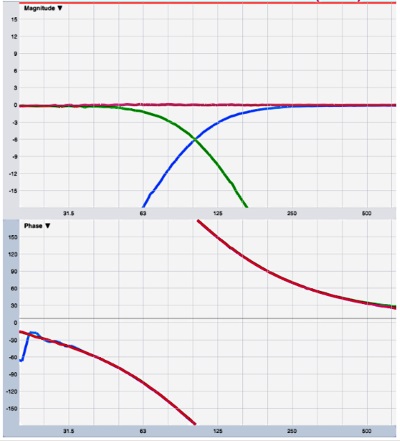
Figure 5
There are a couple layers to this question. The first, and perhaps most obvious, is the crossover filters. We’ll assume that the main/sub crossover uses 24 dB/octave Linkwitz-Riley filters, which are probably the most common in this application and, by no coincidence at all, can sum to create a perfectly matched response in both magnitude and phase, as shown in Figure 5.
Since the phase is matched through the entire spectrum, we can tweak send levels all day with no effect on the phase alignment, at least in the electronic domain.
Figure 6 shows the effects of running the sub feed at -6 dB and +6 dB, along with a whopping +18 dB for those who really like to party. This has the effect of sweeping fc (because changing the relative level of the two feeds alters the frequency at which they meet at equal level), previously at 100 Hz, from as low as 86 Hz to an inadvisable 176 Hz, but the bottom pane shows that we’ve done all this without disturbing the summation in the slightest.
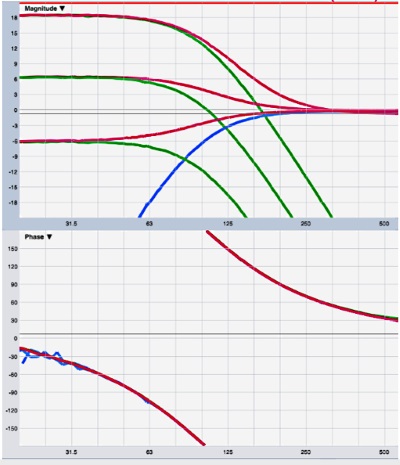
Figure 6
A bit more elusive is the additional effect of the loudspeakers themselves – the phase response at the top end of a subwoofer’s range is unlikely to match that of the lower range of the mains. So how bad is it? The realistic answer here is “it depends.”
Figure 7 shows the crossover alignment data from a small club install. We can see a virtually perfect (ahem…) alignment over almost two full octaves, from 63 to 250 Hz. This gives quite a bit of wiggle room for running an input’s sub send a bit higher or lower, sweeping the effective fc throughout this range.
With many systems, this is not likely to be the case, but if the entire main/sub alignment is so tenuous, one might reasonably ask why the fuss over individual inputs.
And there’s the rub: I’m comfortable making the statement that this isn’t what ruins shows. No one has ever come home from a concert and said, “It was a great concert, but the main/sub alignment was terrible.”

Figure 7
Art Of Compromise
In fact, I feel that the “perfect sub alignment” is a bit of a mythical unicorn as a whole. Unless the subs are flown directly adjacent to the mains (and the fact that we don’t demand this on every show is an indicator of where this priority falls), the best-case alignment is a compromise decision that spreads the error over the space.
If you don’t like the main/sub alignment, in most rooms you can experience a different one simply by changing seats. There are many other mix and optimization factors that play a much larger role in a successful show, but for some reason the sub alignment tends to get more attention. Frankly, I don’t see this to be an overwhelming problem, and so too for the micro version of the problem as it concerns an individual input.
In conclusion, neither the input-splitting technique and variable-level aux-fed subs are without possible drawbacks, but in my opinion they both have the potential to provide some clear, significant, measurable and audible advantages in many mixing situations. Through this investigation, I’ve learned that there is perhaps not as much cause for concern as some might believe.